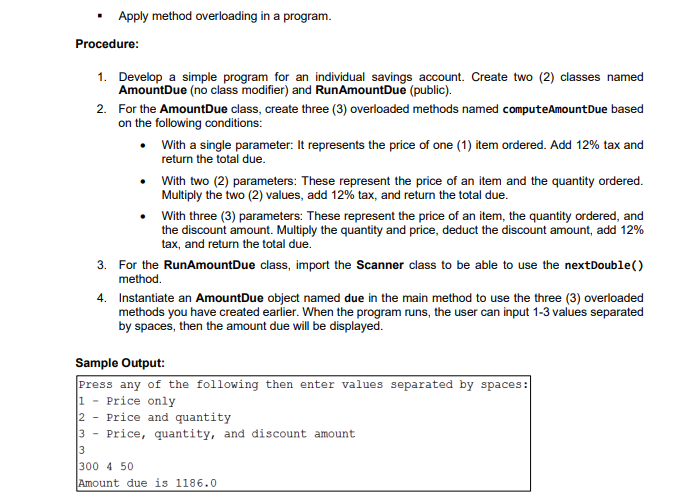Answered step by step
Verified Expert Solution
Question
1 Approved Answer
Apply method overloading in a program. Procedure: 1. Develop a simple program for an individual savings account. Create two (2) classes named AmountDue (no

Apply method overloading in a program. Procedure: 1. Develop a simple program for an individual savings account. Create two (2) classes named AmountDue (no class modifier) and RunAmount Due (public). 2. For the Amount Due class, create three (3) overloaded methods named computeAmount Due based on the following conditions: With a single parameter: It represents the price of one (1) item ordered. Add 12% tax and return the total due. With two (2) parameters: These represent the price of an item and the quantity ordered. Multiply the two (2) values, add 12% tax, and return the total due. With three (3) parameters: These represent the price of an item, the quantity ordered, and the discount amount. Multiply the quantity and price, deduct the discount amount, add 12% tax, and return the total due. 3. For the RunAmountDue class, import the Scanner class to be able to use the nextDouble() method. 4. Instantiate an Amount Due object named due in the main method to use the three (3) overloaded methods you have created earlier. When the program runs, the user can input 1-3 values separated by spaces, then the amount due will be displayed. Sample Output: Press any of the following then enter values separated by spaces: 1- Price only 2 Price and quantity 3 Price, quantity, and discount amount 3 300 4 50 Amount due is 1186.0
Step by Step Solution
There are 3 Steps involved in it
Step: 1

Get Instant Access to Expert-Tailored Solutions
See step-by-step solutions with expert insights and AI powered tools for academic success
Step: 2

Step: 3

Ace Your Homework with AI
Get the answers you need in no time with our AI-driven, step-by-step assistance
Get Started


